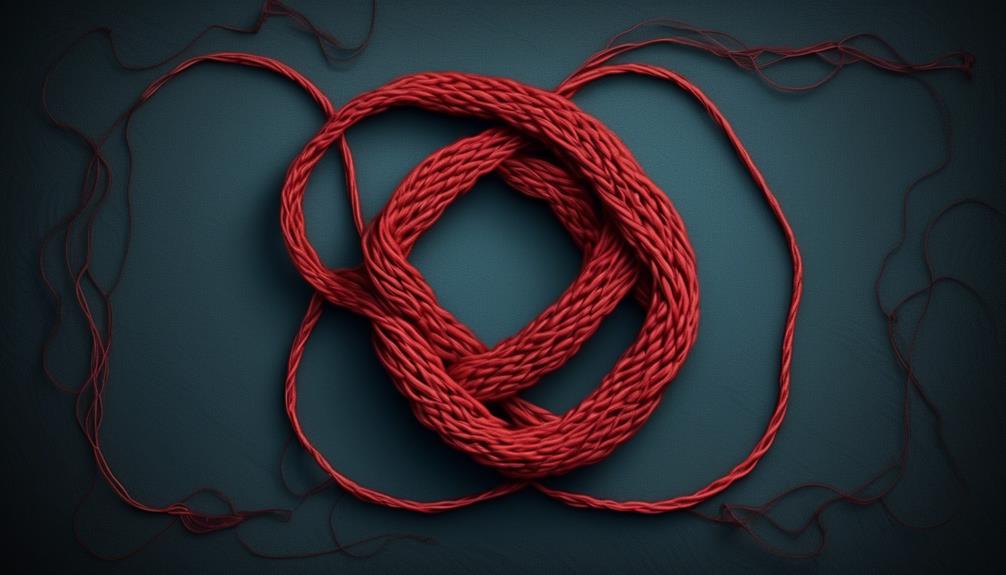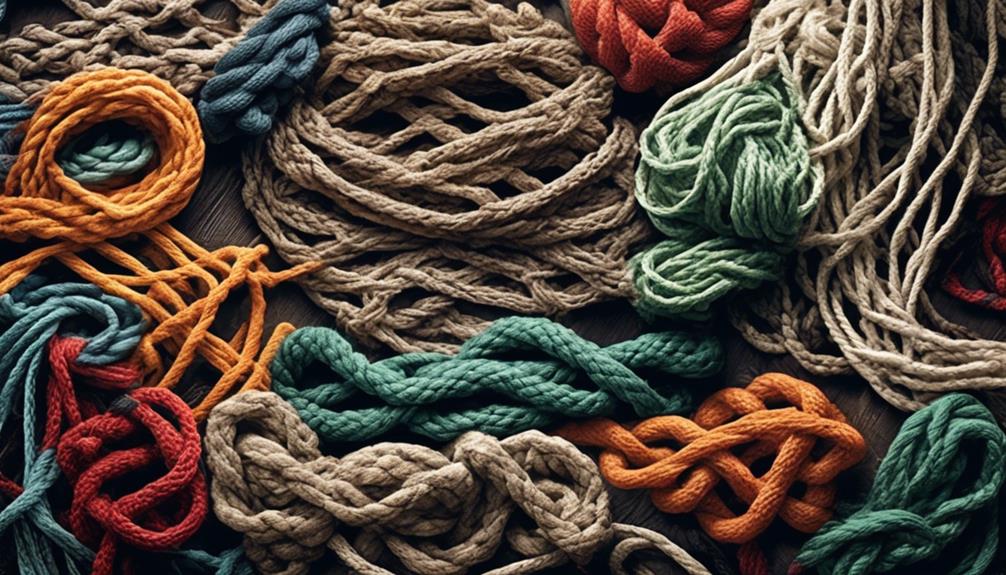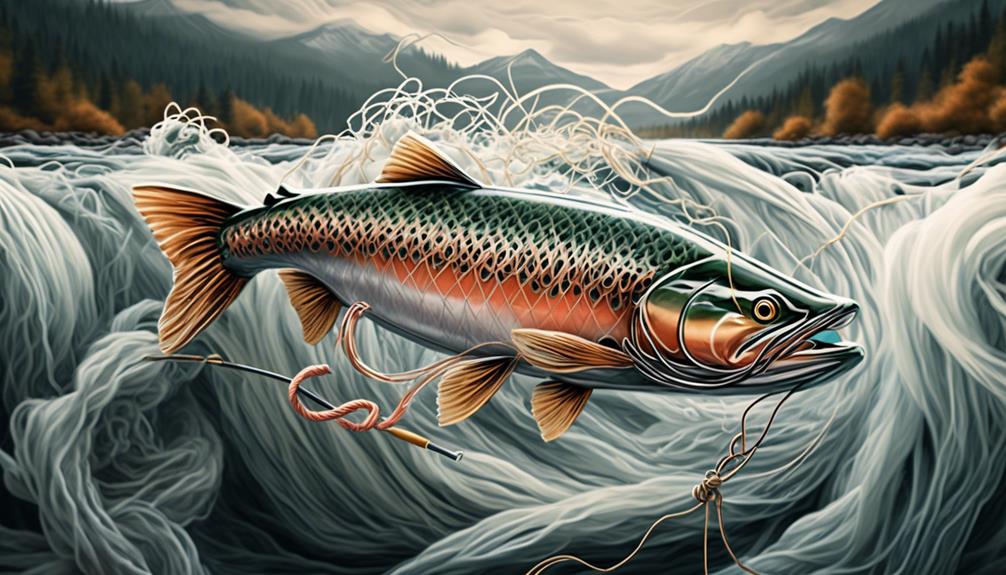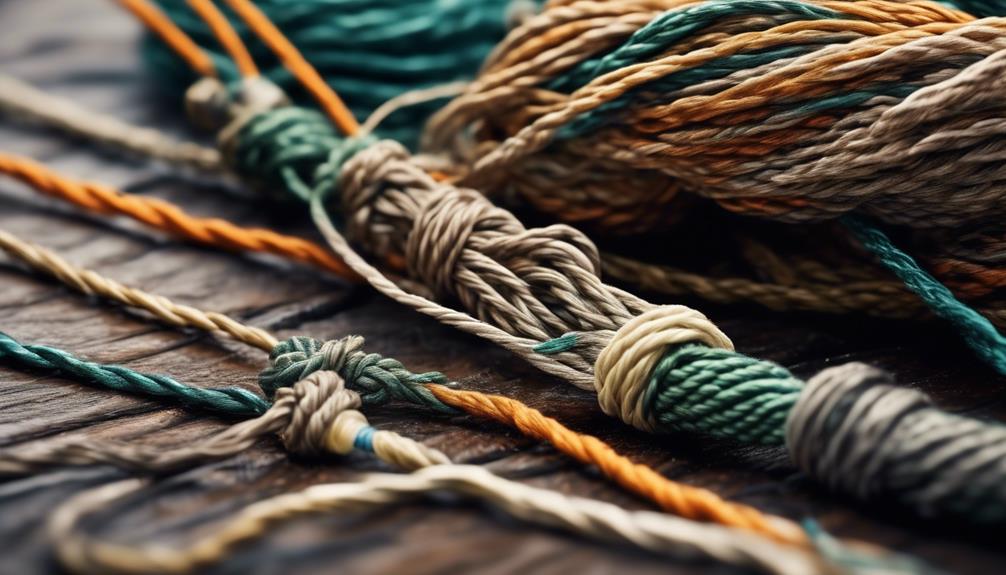Tying two fishing lines together may seem like a simple task, but there's an art to it that can make a significant difference in your fishing experience. You might have encountered situations where a poorly tied knot has cost you a catch, or worse, a prized lure.
Understanding the nuances of different fishing knots and mastering the techniques can be the key to avoiding such disappointments. So, if you've ever struggled with tying two fishing lines securely, or if you're looking to enhance your knot-tying skills, there's a lot to explore in this fundamental aspect of fishing.
Importance of Fishing Knots
Understanding the importance of fishing knots is crucial for ensuring a secure and reliable connection between your line and tackle. When you're out on the water, the last thing you want is for your knot to fail when you've hooked the big one. Strength and reliability are key when it comes to fishing knots. A strong knot will prevent your line from breaking when you're reeling in a fish, ensuring that your catch makes it all the way to the boat. Reliability is equally important; you need to have confidence that your knot will hold firm under pressure.
In addition to strength and reliability, the ease of tying and untying a fishing knot is also essential. You don't want to spend precious time struggling to tie a complicated knot when you could be casting your line. Simple, easy-to-tie knots are best for practical reasons. Furthermore, if you need to change your tackle or adjust your setup, being able to quickly untie a knot without damaging your line is invaluable. The last thing you want is to be fumbling with a stubborn knot while the fish are biting.
Types of Fishing Knots
When tying fishing lines, it's essential to be familiar with various types of fishing knots to ensure a secure and reliable connection between your line and tackle. Different fishing knots serve different purposes, and understanding their knot strength and applications is crucial for successful fishing experiences.
Here are some types of fishing knots to consider:
- Loop Knots:
- Non-slip Loop Knot: This knot is ideal for attaching lures or hooks as it allows them to move more naturally in the water, enhancing the presentation of your bait.
- Perfection Loop: Known for its strength and reliability, this knot is suitable for forming a loop at the end of the line. It's commonly used in fly fishing.
- Terminal Connection Knots:
- Improved Clinch Knot: This knot is popular for tying hooks, swivels, and lures to the line. It's relatively easy to tie and offers good knot strength.
- Blood Knot: Often used in fly fishing, the blood knot is excellent for joining two lines of similar diameters. It maintains a high knot strength, making it reliable for connecting leader materials.
- Line-to-Line Knots:
- Albright Knot: This knot is effective for joining two lines of different materials or diameters. It provides strong and smooth connections, making it suitable for connecting backing to the fly line in fly fishing.
Understanding the strengths and applications of these various types of fishing knots will enable you to select the most suitable knot for different fishing scenarios, ultimately enhancing your fishing success.
Basic Overhand Knot
The 'Basic Overhand Knot' is a fundamental knot used in various fishing applications, providing a simple and reliable method for securing the end of a line. This knot is easy to tie and is often the starting point for more complex knots.
The double overhand knot, which is essentially the basic overhand knot with an additional pass through the loop, is slightly stronger. When comparing the strength of the two knots, the double overhand knot is preferred when added security is needed, such as when tying a hook to the line or attaching two lines together.
The basic overhand knot has numerous practical applications in fishing. It's commonly used to create a stopper knot at the end of the line to prevent swivels, hooks, or other terminal tackle from sliding off. Additionally, it can be used as a starting point for more complex knots, such as the surgeon's knot or the blood knot.
The simplicity and versatility of the basic overhand knot make it an essential skill for any angler.
Improved Clinch Knot
As you move on from mastering the basic overhand knot, the improved clinch knot becomes a valuable skill for securing hooks, lures, or swivels to your fishing line with confidence. This knot is renowned for its reliability and strength, making it a favorite among anglers.
To tie the improved clinch knot, follow these steps:
- Thread the Line: Start by threading about 6 inches of the line through the eye of the hook, then double back and make 5 to 7 turns around the line.
- Make sure the turns are neatly wrapped and don't overlap.
- Ensure that the tag end passes through the first loop formed behind the eye of the hook.
- Moisten the knot with saliva or water before tightening to reduce friction and heat, which can weaken the line.
The improved clinch knot is known for its exceptional knot strength, allowing you to confidently battle larger fish without fear of the knot slipping or breaking. When tying this knot, pay close attention to the knot tying techniques to ensure it's properly secured.
With practice, you'll become adept at tying this knot quickly and efficiently, giving you more time to focus on the thrill of reeling in your prized catch.
Palomar Knot
To tie the Palomar knot, double the line and pass it through the eye of the hook or swivel. Then, tie a simple overhand knot, but don't pull it tight just yet. Next, loop the doubled line over the hook or swivel and then pass the hook through the loop. Moisten the knot and pull both ends of the line to tighten it.
The Palomar knot is known for its strength and is particularly effective for braided lines. Its simplicity makes it a favorite among anglers, and once mastered, it can be tied quickly even in adverse conditions.
When it comes to knot strength, the Palomar knot excels. The double line through the eye of the hook or swivel distributes the pressure evenly, minimizing the risk of breakage. This knot is particularly reliable for heavier lines and larger fish, making it a popular choice for many anglers.
In terms of knot tying techniques, the Palomar knot is relatively easy to learn and tie. Its simplicity is one of its greatest advantages, as it can be quickly and effectively tied even by those new to fishing. With just a few practice runs, anglers can master the Palomar knot and have confidence in its strength and reliability for various fishing situations.
Double Uni Knot
After mastering the Palomar knot, you'll appreciate the strength and reliability of the Double Uni knot for connecting two fishing lines. This knot is known for its outstanding line strength and is widely used in various fishing techniques.
Here's why the Double Uni knot is essential for every angler:
- Versatile Application: The Double Uni knot is highly versatile and can be used to join lines of different materials and diameters. Whether you need to connect a braided line to a monofilament leader or join two lines of different strengths, the Double Uni knot proves to be a dependable choice.
- Minimal Line Weakening: When tied correctly, the Double Uni knot maintains a significant portion of the line's original strength. This is crucial for withstanding the powerful resistance of large fish, especially when employing heavy-duty fishing techniques such as deep-sea or big game fishing.
- Smooth Passage Through Guides: Unlike bulkier knots, the Double Uni knot slides smoothly through the guides of a fishing rod. This seamless movement reduces the risk of tangles and allows for longer, more precise casts, particularly when using advanced casting techniques like surf casting or fly fishing.
Mastering the Double Uni knot is an essential skill for any angler, as it not only ensures the integrity of your line but also plays a significant role in the successful execution of various fishing techniques.
Blood Knot

Enhancing your fishing expertise involves mastering the technique of tying a Blood Knot for seamlessly joining two lines of similar or dissimilar diameters. The Blood Knot is a widely-used and reliable method for connecting lines, especially in scenarios where a strong and smooth connection is essential. This knot is particularly popular among anglers for its simplicity and knot strength.
To tie a Blood Knot, start by overlapping the ends of the two lines to be joined. Then, take one end and wrap it around the other line 5-7 times. Next, thread the end through the gap between the two lines, and repeat the same wrapping process with the other line. Once both ends have been wrapped and threaded through the gap, moisten the knot and pull the lines in opposite directions to tighten the knot. Trim the tag ends, and you have successfully tied a Blood Knot.
One of the key advantages of the Blood Knot is its exceptional knot strength, making it a reliable choice for securing two lines together. When executed correctly, this knot maintains a high percentage of the lines' original strength, ensuring that the connection point is dependable and durable. Additionally, the low profile of the Blood Knot allows it to pass through rod guides smoothly, minimizing any interference during casting and retrieval.
Mastering the Blood Knot tying technique is a valuable skill that will undoubtedly enhance your fishing proficiency, providing you with a dependable method for joining fishing lines with confidence.
Leader Knots
Learning to tie leader knots effectively is essential for ensuring the strength and reliability of your fishing setup. When tying leader knots, it's crucial to consider the material properties of the leader and the mainline to ensure a strong and secure connection. Here are some key points to keep in mind:
- Leader Knot Strength
- The strength of the leader knot is vital for withstanding the intense pressure exerted by powerful fish. A strong leader knot ensures that the connection between the leader and the mainline remains intact during the fight, reducing the risk of breakage and potential loss of the catch.
- Different leader knot techniques offer varying degrees of strength. It's important to choose a knot that maximizes the strength of the connection without compromising the overall performance of the fishing setup.
- Leader Knot Material Properties
- The material properties of the leader and the mainline play a significant role in determining the effectiveness of the leader knot. Understanding the characteristics of the materials used allows for the selection of the most suitable knot for optimal performance.
- Factors such as abrasion resistance, tensile strength, and flexibility should be considered when choosing a leader knot to ensure compatibility with the specific properties of the leader and mainline materials.
Frequently Asked Questions
Can Different Types of Fishing Lines Be Tied Together Using These Knots?
Yes, different types of fishing lines can be tied together using these knots. Line compatibility and strength are crucial factors. Proper knot lubrication and tensioning ensure a secure bond.
Choose the right knot for the specific lines being joined to maintain strength and reduce the risk of breakage. Consider the characteristics of each line to determine the best knot for compatibility and strength.
Are There Any Specific Tips for Tying Fishing Knots in Windy Conditions?
When tying knots in windy conditions, consider using thicker lines for better handling. Ensure the knot strength and line compatibility are suitable for the fishing techniques you plan to use. Also, factor in weather considerations to make adjustments as needed.
Secure the lines and knots carefully to prevent any mishaps. Always be mindful of the wind's impact on your fishing gear and take proper precautions.
How Do I Choose the Right Knot for Different Types of Fishing Scenarios?
When choosing the right knot for different fishing scenarios, consider the fishing line compatibility. For braid, the Palomar knot works well, while the double uni knot is great for tying fluorocarbon.
Match the knot to the line type and the fishing situation. Always test the knots to ensure they hold securely.
Keep in mind the size and type of fish you're targeting, as this can also influence your knot choice.
Are There Any Common Mistakes to Avoid When Tying Fishing Knots?
When tying fishing knots, common mistakes can lead to weakened knot strength and potential frustration. To avoid this, it's crucial to focus on proper technique. Pay attention to details like wrapping the line evenly and ensuring a tight cinch. This will improve efficiency and overall knot strength.
Additionally, be mindful of not rushing the process, as taking your time to tie the knot correctly can make a significant difference in your fishing success.
Can These Knots Be Used for Both Freshwater and Saltwater Fishing?
Yes, these knots can be used for both freshwater and saltwater fishing.
It's important to consider line strength and compatibility when tying fishing knots for different environments.
Additionally, ensure that the knots offer corrosion resistance and strength, as saltwater conditions can be harsh on fishing gear.
Conclusion
So, next time you're out on the water, make sure you have mastered the art of tying two fishing lines.
Understanding the different types of fishing knots and when to use them can make a huge difference in your fishing success.
Practice tying these knots until they become second nature, and you'll be ready to tackle any fishing challenge that comes your way.
Happy fishing!



